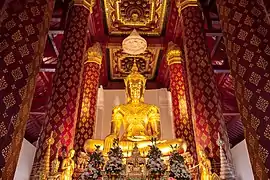| Wat Na Phra Men | |
|---|---|
วัดหน้าพระเมรุ | |
 The ubosot and the striking gable | |
| Religion | |
| Affiliation | Buddhism |
| Sect | Theravāda Mahā Nikāya |
| Status | Third-class royal temple |
| Location | |
| Location | 76 Moo 4, Lumphli, Phra Nakhon Si Ayutthaya District, Phra Nakhon Si Ayutthaya, 13000 |
| Country | Thailand |
| Geographic coordinates | 14°22′N 100°34′E / 14.36°N 100.56°E |
| Architecture | |
| Founder | Unknown |
Wat Na Phra Men, also written as Wat Na Phramen (Thai: วัดหน้าพระเมรุ) is a historic active Buddhist temple in Phra Nakhon Si Ayutthaya Province. Considered as part of Ayutthaya Historical Park and known as a very beautiful temple.
Overview
The temple is located along Khlong Sa Bua on the north bank of the Khlong Khu Mueang (the old course of Lopburi River) just opposite the Ayutthaya Royal Grand Palace. Its location can be considered outside the Ayutthaya Island. Previously known as "Wat Phra Merurachikaram" (วัดหน้าพระเมรุราชิการาม).[1][2]
The temple was built since the time when Ayutthaya was the capital without knowing who built it and the exact year of creation. The name "Na Phra Men", literally translated as "in front of royal cremation", hence it is assumed that it was built as a cremation site for nobility or royal family in the Ayutthaya period.
Wat Na Phra Men is one of the few temples in the Ayutthaya Historical Park that were not burned by the Ava troops during the fall of Ayutthaya in 1767. The temple is therefore still able to maintain its exquisite condition after many renovations during the Rattanakosin period.
The outstanding construction is the ubosot (ordination hall)'s gable is featuring Lord Vishnu mounted on garuda, on top of the demon Rāhu placed between two nāgas and flanked by 26 devas.
The ubosot faces south and measures approximately 50 m (164.0 ft) by 16 m (52.5 ft). Inside there are octagonal columns. The top of the columns were made in the form of closed lotuses to support the large roof. The ceiling was decorated with carved wood and coloured glasses showing the meaning of beautiful stars in the celestial.[2]
The principal Buddha image is seated in the gesture of subduing Māra, and wears royal attire. The Buddha full name is "Phra Buddha Nimitr Vichit Maramoli Sisanpeth Boromtrailokanat" (พระพุทธนิมิตวิชิตมารโมลีศรีสรรเพชญบรมไตรโลกนาถ; abbreviated as Phra Buddha Nimitr) with the lap of 4.40 m (14.4 ft) wide and 6 m (19.7 ft) high. Its name was given by King Rama III.[3]
Another principal Buddha image is "Phra Khanthararaj" (พระคันธารราฐ), which is enshrined inside the viharn noi (chapel) beside the ubosot. It is a green stone Buddha image that is presumed to be more than 1,500 years old, from the Dvaravati period. Considered as one of five seated Buddha images in this type in Thailand which is worth preserved.[1]
The temple is now a recognised ancient monument since 1935 by the Fine Arts Department.
Gallery
 Phra Khanthararaj
Phra Khanthararaj Phra Buddha Nimitr
Phra Buddha Nimitr Ruined chedis
Ruined chedis.jpg.webp) Mural painting
Mural painting.jpg.webp) The temple
The temple
See also
References
- 1 2 "กราบพระคันธารราฐอายุกว่า 1,500 ปี ณ "วัดหน้าพระเมรุ" อยุธยา" [Pay respects to the Phra Khanthararaj over 1,500 years old at "Wat Na Phra Men", Ayutthaya]. ASTV Manager (in Thai). 2021-09-09. Retrieved 2022-04-26.
- 1 2 "Wat Na Phramen". TAT.
- ↑ "พระพุทธรูปทรงเครื่องกษัตริย์ ที่ใหญ่และงามที่สุดของกรุงศรีฯ รอดจากถูกพม่าเผาทำลายอย่างน่าอัศจรรย์" [The great and most beautiful Buddha image in royal robes in Ayutthaya miraculously survived being burned by Burmese]. ASTV Manager (in Thai). 2017-07-04. Retrieved 2022-04-26.